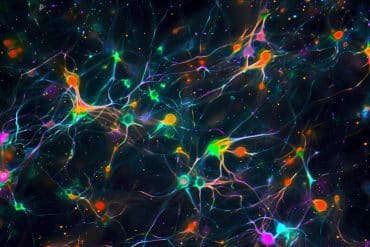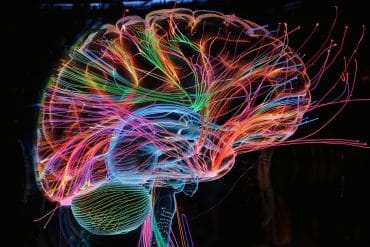Summary: According to researchers, endurance runners appear to have greater functional connectivity in their brains that those who don’t exercise as much.
Source: University of Arizona.
MRI scans show that running may affect the structure and function of the brain in ways similar to complex tasks like playing a musical instrument
If you’re thinking about taking up running as your New Year’s resolution and still need some convincing, consider this: MRI scans reveal that endurance runners’ brains have greater functional connectivity than the brains of more sedentary individuals.
University of Arizona researchers compared brain scans of young adult cross country runners to young adults who don’t engage in regular physical activity. The runners, overall, showed greater functional connectivity — or connections between distinct brain regions — within several areas of the brain, including the frontal cortex, which is important for cognitive functions such as planning, decision-making and the ability to switch attention between tasks.

Although additional research is needed to determine whether these physical differences in brain connectivity result in differences in cognitive functioning, the current findings, published in the journal Frontiers in Human Neuroscience, help lay the groundwork for researchers to better understand how exercise affects the brain, particularly in young adults.
UA running expert David Raichlen, an associate professor of anthropology, co-designed the study with UA psychology professor Gene Alexander, who studies brain aging and Alzheimer’s disease as a member of the UA’s Evelyn F. McKnight Brain Institute.
“One of the things that drove this collaboration was that there has been a recent proliferation of studies, over the last 15 years, that have shown that physical activity and exercise can have a beneficial impact on the brain, but most of that work has been in older adults,” Raichlen said.
“This question of what’s occurring in the brain at younger ages hasn’t really been explored in much depth, and it’s important,” he said. “Not only are we interested in what’s going on in the brains of young adults, but we know that there are things that you do across your lifespan that can impact what happens as you age, so it’s important to understand what’s happening in the brain at these younger ages.”
Along with their colleagues, Raichlen and Alexander compared the MRI scans of a group of male cross country runners to the scans of young adult males who hadn’t engaged in any kind of organized athletic activity for at least a year. Participants were roughly the same age — 18 to 25 — with comparable body mass index and educational levels.
The scans measured resting state functional connectivity, or what goes on in the brain while participants are awake but at rest, not engaging in any specific task.
The findings shed new light on the impact that running, as a particular form of exercise, may have on the brain.
Previous studies have shown that activities that require fine motor control, such as playing a musical instrument, or that require high levels of hand-eye coordination, such as playing golf, can alter brain structure and function. However, fewer studies have looked at the effects of more repetitive athletic activities that don’t require as much precise motor control — such as running. Raichlen’s and Alexander’s findings suggest that these types of activities could have a similar effect.
“These activities that people consider repetitive actually involve many complex cognitive functions — like planning and decision-making — that may have effects on the brain,” Raichlen said.
Since functional connectivity often appears to be altered in aging adults, and particularly in those with Alzheimer’s or other neurodegenerative diseases, it’s an important measure to consider, Alexander said. And what researchers learn from the brains of young adults could have implications for the possible prevention of age-related cognitive decline later on.
“One of the key questions that these results raise is whether what we’re seeing in young adults — in terms of the connectivity differences — imparts some benefit later in life,” said Alexander, who also is a professor of neuroscience and physiological sciences. “The areas of the brain where we saw more connectivity in runners are also the areas that are impacted as we age, so it really raises the question of whether being active as a young adult could be potentially beneficial and perhaps afford some resilience against the effects of aging and disease.”
Co-authors on the paper include Theodore Trouard, UA professor of biomedical engineering and medical imaging; Pradyumna Bharadwaj, research assistant in the UA Department of Psychology; and UA alumni Megan C. Fitzhugh, Kari. A. Haws and Gabrielle-Ann Torre.
Source: Alexis Blue – University of Arizona
Image Source: NeuroscienceNews.com image is credited to Alexander et al./Frontiers in Human Neuroscience.
Original Research: Full open access research for “Differences in Resting State Functional Connectivity between Young Adult Endurance Athletes and Healthy Controls” by David A. Raichlen, Pradyumna K. Bharadwaj, Megan C. Fitzhugh, Kari A. Haws, Gabrielle-Ann Torre, Theodore P. Trouard and Gene E. Alexander in Frontiers in Human Neuroscience. Published online November 29 2016 doi:10.3389/fnhum.2016.00610
[cbtabs][cbtab title=”MLA”]University of Arizona. “Runners’ Brains May Be More Connected.” NeuroscienceNews. NeuroscienceNews, 14 December 2016.
<https://neurosciencenews.com/running-neural-network-5744/>.[/cbtab][cbtab title=”APA”]University of Arizona. (2016, December 14). Runners’ Brains May Be More Connected. NeuroscienceNews. Retrieved December 14, 2016 from https://neurosciencenews.com/running-neural-network-5744/[/cbtab][cbtab title=”Chicago”]University of Arizona. “Runners’ Brains May Be More Connected.” https://neurosciencenews.com/running-neural-network-5744/ (accessed December 14, 2016).[/cbtab][/cbtabs]
Abstract
Differences in Resting State Functional Connectivity between Young Adult Endurance Athletes and Healthy Controls
Expertise and training in fine motor skills has been associated with changes in brain structure, function, and connectivity. Fewer studies have explored the neural effects of athletic activities that do not seem to rely on precise fine motor control (e.g., distance running). Here, we compared resting-state functional connectivity in a sample of adult male collegiate distance runners (n = 11; age = 21.3 ± 2.5) and a group of healthy age-matched non-athlete male controls (n = 11; age = 20.6 ± 1.1), to test the hypothesis that expertise in sustained aerobic motor behaviors affects resting state functional connectivity in young adults. Although generally considered an automated repetitive task, locomotion, especially at an elite level, likely engages multiple cognitive actions including planning, inhibition, monitoring, attentional switching and multi-tasking, and motor control. Here, we examined connectivity in three resting-state networks that link such executive functions with motor control: the default mode network (DMN), the frontoparietal network (FPN), and the motor network (MN). We found two key patterns of significant between-group differences in connectivity that are consistent with the hypothesized cognitive demands of elite endurance running. First, enhanced connectivity between the FPN and brain regions often associated with aspects of working memory and other executive functions (frontal cortex), suggest endurance running may stress executive cognitive functions in ways that increase connectivity in associated networks. Second, we found significant anti-correlations between the DMN and regions associated with motor control (paracentral area), somatosensory functions (post-central region), and visual association abilities (occipital cortex). DMN deactivation with task-positive regions has been shown to be generally beneficial for cognitive performance, suggesting anti-correlated regions observed here are engaged during running. For all between-group differences, there were significant associations between connectivity, self-reported physical activity, and estimates of maximum aerobic capacity, suggesting a dose-response relationship between engagement in endurance running and connectivity strength. Together these results suggest that differences in experience with endurance running are associated with differences in functional brain connectivity. High intensity aerobic activity that requires sustained, repetitive locomotor and navigational skills may stress cognitive domains in ways that lead to altered brain connectivity, which in turn has implications for understanding the beneficial role of exercise for brain and cognitive function over the lifespan.
“Differences in Resting State Functional Connectivity between Young Adult Endurance Athletes and Healthy Controls” by David A. Raichlen, Pradyumna K. Bharadwaj, Megan C. Fitzhugh, Kari A. Haws, Gabrielle-Ann Torre, Theodore P. Trouard and Gene E. Alexander in Frontiers in Human Neuroscience. Published online November 29 2016 doi:10.3389/fnhum.2016.00610






